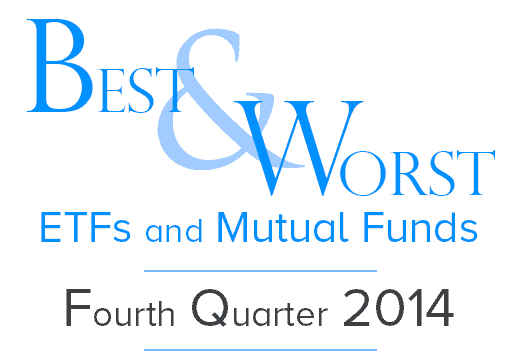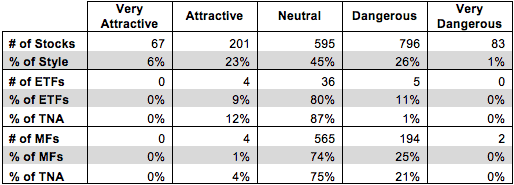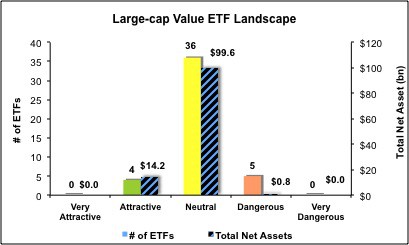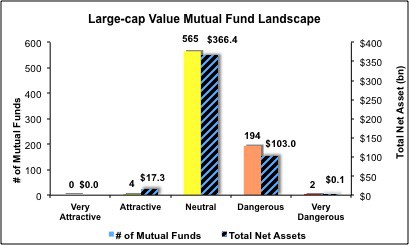The Large Cap Value style ranks second out of the twelve fund styles as detailed in my Style Rankings for ETFs and Mutual Funds report. It gets my Neutral rating, which is based on aggregation of ratings of 45 ETFs and 765 mutual funds in the Large Cap Value style as of October 18, 2013. Prior reports on the best & worst ETFs and mutual funds in every sector and style are here.
Figures 1 and 2 show the five best and worst-rated ETFs and mutual funds in the style. Not all Large Cap Value style ETFs and mutual funds are created the same. The number of holdings varies widely (from 20 to 1407). This variation creates drastically different investment implications and, therefore, ratings. The best ETFs and mutual funds allocate more value to Attractive-or-better-rated stocks than the worst, which allocate too much value to Neutral-or-worse-rated stocks.
To identify the best and avoid the worst ETFs and mutual funds within the Large Cap Value style, investors need a predictive rating based on (1) stocks ratings of the holdings and (2) the all-in expenses of each ETF and mutual fund. Investors need not rely on backward-looking ratings. My fund rating methodology is detailed here.
Investors seeking exposure to the Large Cap Value style should buy one of the Attractive-or-better rated ETFs or mutual funds from Figures 1 and 2.
Get my ratings on all ETFs and mutual funds in this style by searching for Large Cap Value on my free mutual fund and ETF screener.
Figure 1: ETFs with the Best & Worst Ratings – Top 5
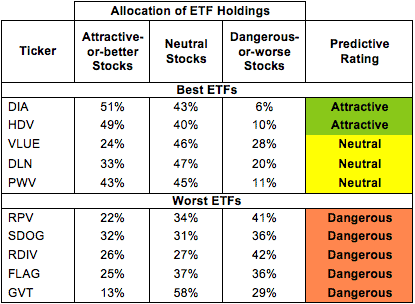
Sources: New Constructs, LLC and company filings
First Trust First Trust Capital Strength ETF (FTCS), WisdomTree U.S. Dividend Growth Fund (DGRW) and WisdomTree Earnings 500 Fund (EPS) are excluded from Figure 1 because their total net assets (TNA) are below $100 million and do not meet our liquidity minimums.
Figure 2: Mutual Funds with the Best & Worst Ratings – Top 5
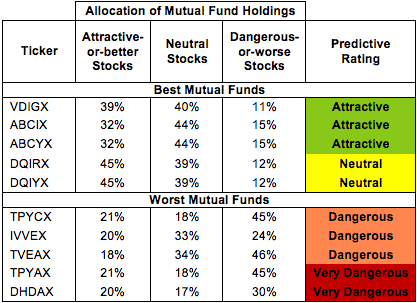
Sources: New Constructs, LLC and company filings
Advisors’ Inner Circle Fund: LSV Conservative Core Equity Fund (LSVPX) is excluded from Figure 2 because its total net assets (TNA) are below $100 million and do not meet our liquidity minimums.
State Street SPDR Dow Jones Industrial Average ETF (DIA) is my top-rated Large Cap Value ETF and Vanguard Specialized Funds: Vanguard Dividend Growth Fund (VDIGX) is my top-rated Large Cap Value mutual fund. Both earn my Attractive rating.
Columbia Concentrated Large Cap Value Strategy Fund (GVT) is my worst-rated Large Cap Value ETF and Destra Investment Trust: Destra Dividend Total Return Fund (DHDAX) is my worst-rated Large Cap Value mutual fund. GVT earns my Dangerous rating and DHDAX earns my Very Dangerous rating.
Figure 3 shows that 268 out of the 1742 stocks (over 29% of the market value) in Large Cap Value ETFs and mutual funds get an Attractive-or-better rating. However, only 4 out of 45 Large Cap Value ETFs (less than 12% of total net assets) and 4 out of 765 Large Cap Value mutual funds (less than 4% of total net assets) get an Attractive-or-better rating.
The takeaways are: mutual fund managers allocate too much capital to low-quality stocks and Large Cap Value ETFs hold poor quality stocks.
Figure 3: Large Cap Value Style Landscape For ETFs, Mutual Funds & Stocks
As detailed in “Low-Cost Funds Dupe Investors”, the fund industry offers many cheap funds but very few funds with high-quality stocks, or with what I call good portfolio management.
Investors need to tread carefully when considering Large Cap Value ETFs and mutual funds, as 91% of Large Cap Value ETFs and 99% of Large Cap Value mutual funds earn a Neutral-or-worse rating. Only 4 ETFs and 4 mutual funds in the Large Cap Value style allocate enough value to Attractive-or-better-rated stocks to earn an Attractive rating.
United Parcel Service, Inc. (UPS) is one of my favorite stocks held by Large Cap Value ETFs and mutual funds and earns my Attractive rating. United Parcel Service has grown after-tax profits (NOPAT) by 10% compounded annually over the last 14 years. The company currently earns a return on invested capital (ROIC) of 23%, which puts it in the top quintile of companies that I cover. Despite the company’s history of strong growth and profitability, UPS trades at ~$92/share, which gives it a price-to-economic book value (PEBV) of 0.93. This valuation implies that the market expects the company’s NOPAT to permanently decline by 7%. Having grown NOPAT by 10% compounded annually over 14 years, these expectations seem to be too pessimistic. A strong growth record and low expectations give UPS an attractive risk/reward profile.
American Water Works Company, Inc. (AWK) is one of my least favorite stocks held by Large Cap Value ETFs and mutual funds and earns my Dangerous rating. American Water Works has grown after-tax profits (NOPAT) by less than 1% compounded annually over the past five years. The company generates a return on invested capital (ROIC) of only 4%, which puts it in the bottom quintile of companies that I cover. American Water Works also has failed to generate any positive economic earnings in the last five years. Despite this poor cash flow record, the stock is still very expensive. To justify AWK’s current price of ~$42/share, the company would have to grow NOPAT by 6% compounded annually over the next 13 years. Having grown after-tax profits by less than 1% compounded annually over the last five years, these expectations seem too high. Poor cash flow and an expensive stock valuation mean that investors should stay away from AWK.
Figures 4 and 5 show the rating landscape of all Large Cap Value ETFs and mutual funds.
My Style Rankings for ETFs and Mutual Funds report ranks all styles and highlights those that offer the best investments.
Figure 4: Separating the Best ETFs From the Worst Funds
Figure 5: Separating the Best Mutual Funds From the Worst Funds
Review my full list of ratings and rankings along with reports on all 45 ETFs and 765 mutual funds in the Large Cap Value style.
Jared Melnyk contributed to this report.
Disclosure: David Trainer and Jared Melnyk receive no compensation to write about any specific stock, sector, style or theme.
